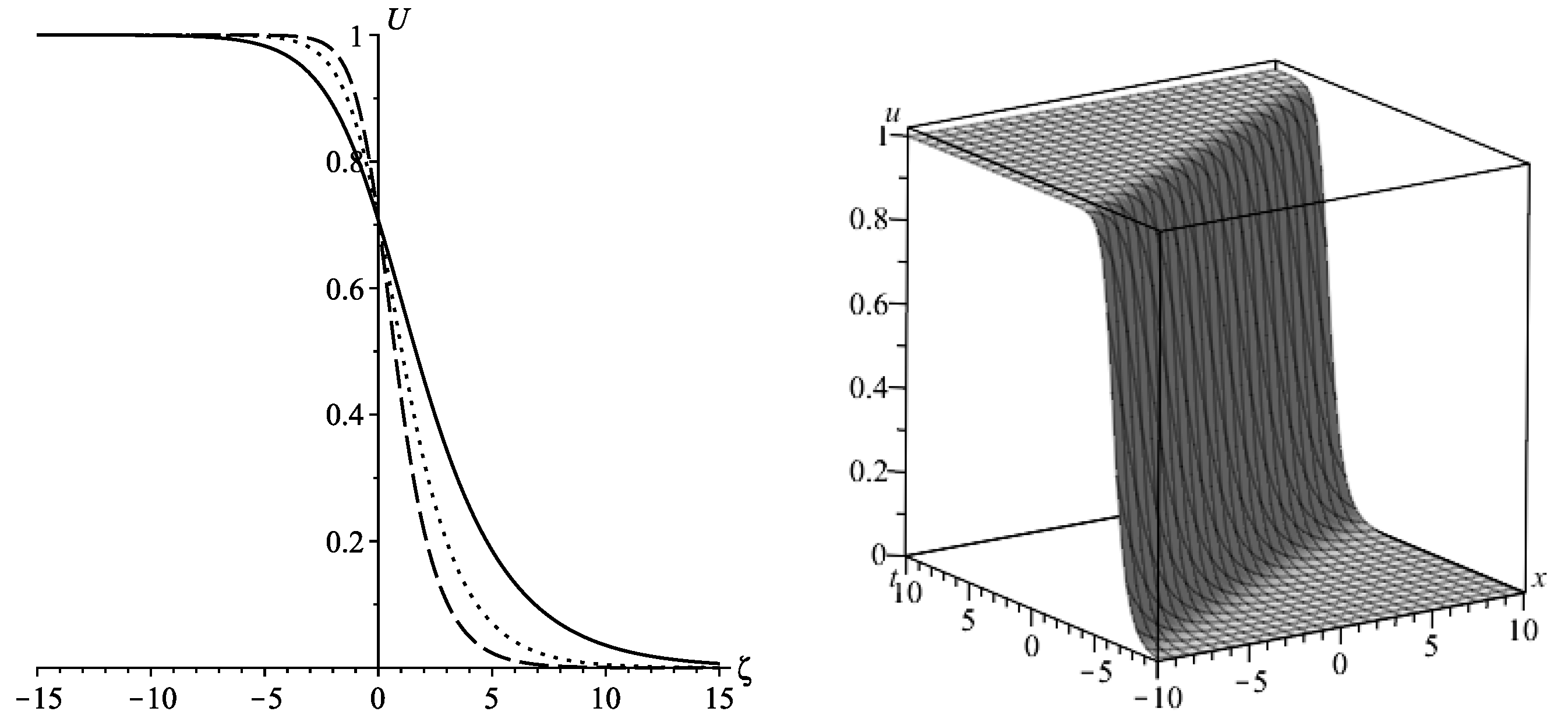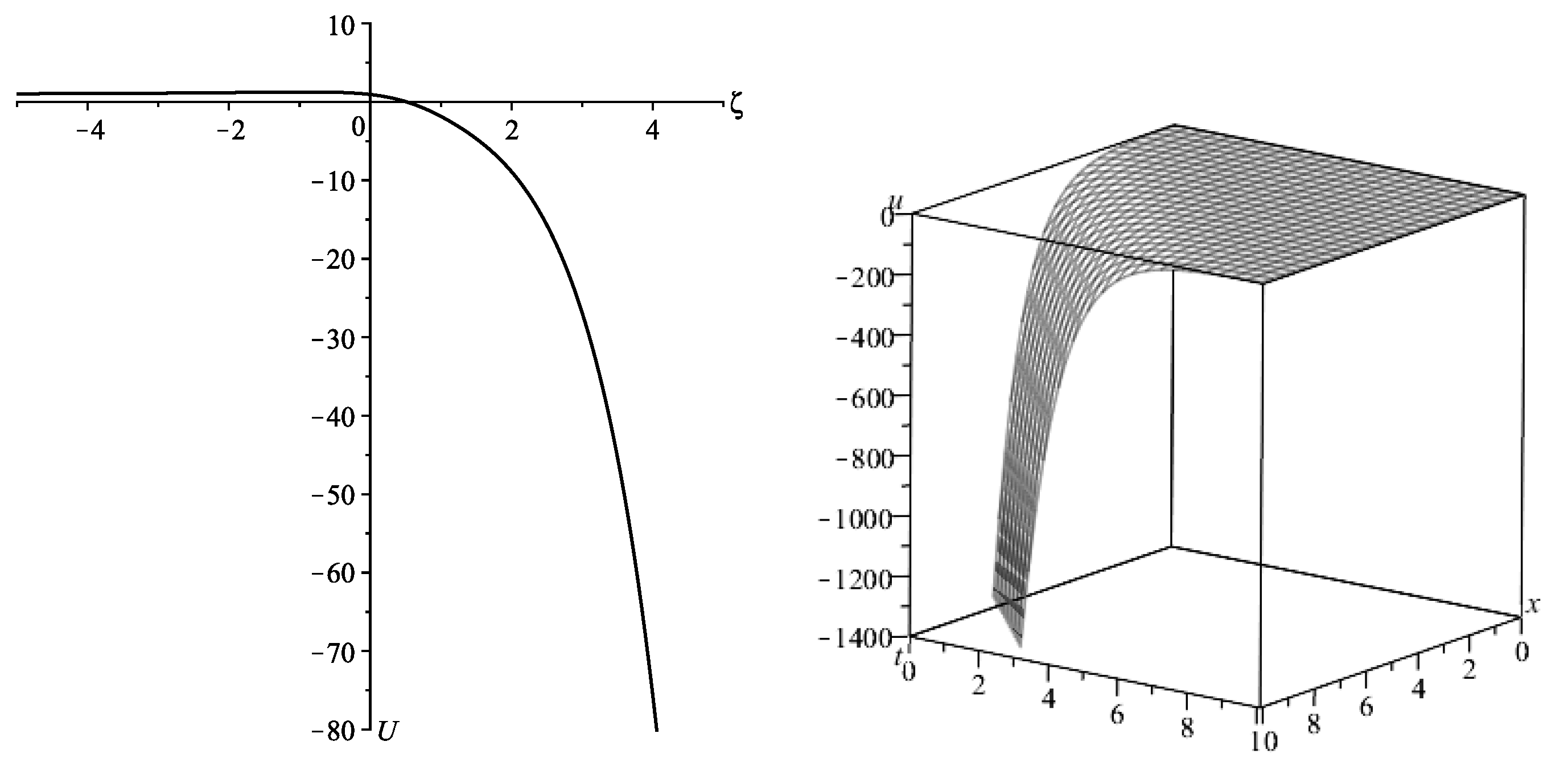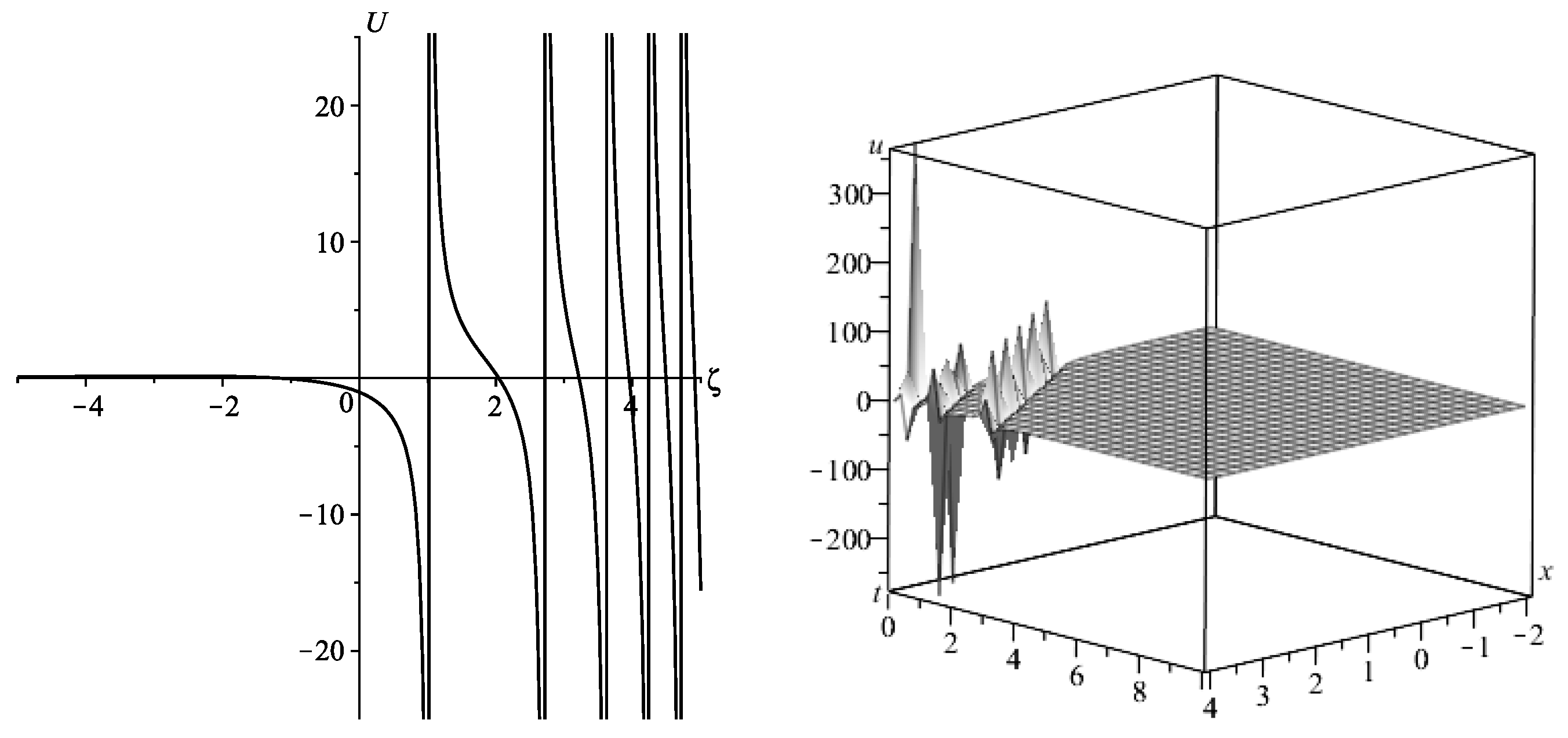Conservation Laws and Exact Solutions for Time-Delayed Burgers–Fisher Equations
Abstract
:1. Introduction
2. Conservation Laws
- (i)
- For , with , arbitrary constants, and arbitrary function,
- (ii)
- For nonlinear function and , with , arbitrary constants,
- (iii)
- For nonlinear function and ,
- (i)
- For , with , arbitrary constants, and arbitrary function,
- (ii)
- For nonlinear function and , with , arbitrary constants,
- (iii)
- For nonlinear function and ,
3. Travelling Waves
3.1. For
3.2. For
4. Equations of Biological Interest: Exact Solutions
For s = 1
- (i)
- For :
- •
- If , the general solution to ODE (44) isHence, the solution to ODE (38) iswhere I and K denote the modified Bessel functions of first and second kind, respectively, and and are integration constants.Figure 2 shows a solitary wave solution given in terms of modified Bessel functions, decaying from an asymptotically constant value.
- •
- If , the general solution to ODE (44) isHence, the solution to ODE (38) iswhere J and Y denote the Bessel functions of first and second kind, respectively, and and are integration constants.Figure 3 represents a solution given in terms of ordinary Bessel functions. This solution becomes a singular solution if the denominator is equal to zero. Thus, depending on the choice of the parameters, it leads to a singular solution. The solution behaves as a rogue wave holding elevation peaks and deep humps.
- (ii)
- For :
- •
- If and , the general solution to ODE (44) isHence, the solution to ODE (38) iswhere are are integration constants.
- •
- If and , the general solution to ODE (44) isHence, the solution to ODE (38) iswhere and are integration constants.
- •
- If and , the general solution to ODE (44) isHence, the solution to ODE (38) iswhere and are integration constants.Figure 6 shows a solitary wave solution decaying to an asymptotically constant value and corresponds to the case . This solution is an exponential sheet.
- •
- If and , the general solution to ODE (44) isHence, the solution to ODE (38) iswhere and are integration constants.Figure 7 represents a solution given in terms of trigonometric functions and corresponds to the case . This solution becomes a singular solution if the denominator is equal to zero. Thus, depending on the choice of the parameters, it leads to a singular solution. The solution behaves as a rogue wave holding elevation peaks and deep humps.
5. Conclusions
Author Contributions
Funding
Acknowledgments
Conflicts of Interest
References
- Burgers, J.M. A mathematical model illustrating the theory of turbulence. Adv. Appl. Mech. 1948, 1, 171–199. [Google Scholar]
- Fisher, R.A. The wave of advance of advantageous genes. Ann. Eugen. 1937, 7, 355–369. [Google Scholar] [CrossRef]
- Kolmogorov, A.; Petrovsky, I.; Piscounov, N. Etude de l’equation de la diffusion avec croissance de la quantité de matière et son application a un probleme biologique. Mosc. Univ. Bull. Math. 1937, 1, 1–25. [Google Scholar]
- Satsuma, J. Topics in Soliton Theory and Exactly Solvable Nonlinear Equations; Ablowitz, M., Fuchssteiner, B., Kruskal, M., Eds.; World Scientific: Singapore, 1987. [Google Scholar]
- Hirsh, R.S. Higher order accurate difference solutions of fluid mechanics problems by a compact differencing technique. J. Comput. Phys. 1975, 19, 90–109. [Google Scholar] [CrossRef]
- Greeshields, B.; Bibbins, J.; Channing, W.; Miller, H. A study of traffic capacity. In Highway Research Board Proceedings; National Research Council: Washington, DC, USA, 1935; Volume 1935, pp. 448–477. Available online: https://onlinepubs.trb.org/Onlinepubs/hrbproceedings/14/14P1-023.pdf (accessed on 16 May 2023).
- Wang, X.; Lu, Y. Exact solutions of the extended Burgers-Fisher equation. Chin. Phys. Lett. 1990, 7, 145–147. [Google Scholar]
- Lu, J.; Yu-Cui, G.; Shu-Jiang, X. Some new exact solutions to the Burgers-Fisher equation and generalized Burgers-Fisher equation. Chin. Phys. 2007, 16, 2514–2522. [Google Scholar] [CrossRef]
- Chen, H.; Zhang, H. New multiple soliton solutions to the general Burgers-Fisher equation and the Kuramoto-Sivashinsky equation. Chaos Solitons Fractals 2004, 19, 71–76. [Google Scholar] [CrossRef]
- Wazwaz, A.M. The tanh method for generalized forms of nonlinear heat conduction and Burgers-Fisher equations. Appl. Math. Comput. 2005, 169, 321–338. [Google Scholar] [CrossRef]
- Wazzan, L. A modified tanh-coth method for solving the general Burgers-Fisher and the Kuramoto-Sivashinsky equations. Commun. Nonlinear Sci. Numer. Simul. 2005, 14, 2642–2652. [Google Scholar] [CrossRef]
- Wang, X.Y.; Zhu, Z.S.; Lu, Y.K. Solitary wave solutions of the generalised Burgers-Huxley equation. J. Phys. A Math. Gen. 1990, 23, 271–274. [Google Scholar] [CrossRef]
- Abdusalam, H.A. Exact analytic solution of the simplified telegraph model of propagation and dissipation of excitation fronts. Int. J. Theor. Phys. 2004, 43, 1161–1167. [Google Scholar] [CrossRef]
- Ahmed, E.; Abdusalam, H.A. On modified Black-Scholes equation. Chaos Solitons Fractals 2004, 22, 583–587. [Google Scholar] [CrossRef]
- Kar, S.; Banik, S.K.; Ray, D.S. Exact solutions of Fisher and Burgers equations with finite transport memory. J. Phys. A Math. Gen. 2003, 36, 2771–2780. [Google Scholar] [CrossRef]
- Mishra, A.; Kumar, R. Memory effects in Fisher equation with nonlinear convection term. Phys. Lett. A 2012, 376, 1833–1835. [Google Scholar] [CrossRef]
- Rosa, M.; Bruzón, M.S.; Gandarias, M.L. Lie symmetries and conservation laws of a Fisher equation with nonlinear convection term. Discret. Contin. Dyn. Syst. 2015, 8, 1331–1339. [Google Scholar] [CrossRef]
- Fahmy, E.S. Travelling wave solutions for some time-delayed equations through factorizations. Chaos Solitons Fractals 2008, 38, 1209–1216. [Google Scholar] [CrossRef]
- Tang, B.; Fan, Y.; Wang, X.; Wang, J.; Chen, S. Traveling wave solutions of the time-delayed generalized Burgers-type equations. SpringerPlus 2016, 5, 2094. [Google Scholar] [CrossRef]
- Xi-Jun, D.; Li-Bo, H.; Xi, L. Travelling solitary wave solutions for generalized time-delayed Burgers-Fisher equation. Commun. Theor. Phys. 2009, 52, 284–286. [Google Scholar] [CrossRef]
- Kim, H.; Sakthivel, R. Travelling wave solutions for time-delayed nonlinear evolution equations. Appl. Math. Lett. 2010, 23, 527–532. [Google Scholar] [CrossRef]
- Zhang, J.; Wei, P.; Wang, M. The investigation into the exact solutions of the generalized time-delayed Burgers-Fisher equation with positive fractional power terms. Appl. Math. Model. 2012, 36, 2192–2196. [Google Scholar] [CrossRef]
- Anco, S.C.; Gandarias, M.L. Symmetry multi-reduction method for partial differential equations with conservation laws. Commun. Nonlinear Sci. Numer. Simul. 2020, 91, 105349. [Google Scholar] [CrossRef]
- Anco, S.C.; Bluman, G.W. Direct construction method for conservation laws of partial differential equations. I. Examples of conservation law classifications. Eur. J. Appl. Math. 2002, 13, 545–566. [Google Scholar] [CrossRef]
- Anco, S.C.; Bluman, G.W. Direct construction method for conservation laws of partial differential equations Part II: General treatment. Eur. J. Appl. Math. 2002, 41, 567–585. [Google Scholar] [CrossRef]
- Olver, P.J. Applications of Lie Groups to Differential Equations; Springer: New York, NY, USA, 1986. [Google Scholar]
- Bluman, G.W.; Anco, S.C. Symmetry and Integration Methods for Differential Equations; Applied Mathematical Sciences Series; Springer: New York, NY, USA, 2002; Volume 154. [Google Scholar]
- Bluman, G.W.; Cheviakov, A.; Anco, S.C. Applications of Symmetry Methods to Partial Differential Equations; Springer Applied Mathematics Series 168; Springer: New York, NY, USA, 2010. [Google Scholar]
- Anco, S.C. Generalization of Noether’s theorem in modern form to non-variational partial differential equations. In Recent Progress and Modern Challenges in Applied Mathematics, Modeling and Computational Science; Fields Institute Communications: Toronto, ON, Canada, 2017; Volume 79, pp. 119–182. [Google Scholar]
- Kamke, E. Differentialgleichungen Lösungsmethoden und Lösungen; Vieweg+Teubner Verlag: Wiesbaden, Germany, 2013. [Google Scholar]
- Srivastava, H.M.; Choi, J. Series Associated with the Zeta and Related Functions; Kluwer Academic Publishers: Amsterdam, The Netherlands, 2001; Volume 530. [Google Scholar]
- Mendoza, J.; Muriel, C. New exact solutions for a generalised Burgers-Fisher equation. Chaos Solitons Fractals 2021, 152, 111360. [Google Scholar] [CrossRef]
- Murray, J.D. Mathematical Biology. I. An Introduction, Interdisciplinary Applied Mathematics; Springer: New York, NY, USA, 2001; Volume 17. [Google Scholar]
- Olver, F.W.J.; Maximon, L.C. Bessel function. In NIST Handbook of Mathematical Functions; Cambridge University Press: Cambridge, UK, 2010. [Google Scholar]






Disclaimer/Publisher’s Note: The statements, opinions and data contained in all publications are solely those of the individual author(s) and contributor(s) and not of MDPI and/or the editor(s). MDPI and/or the editor(s) disclaim responsibility for any injury to people or property resulting from any ideas, methods, instructions or products referred to in the content. |
© 2023 by the authors. Licensee MDPI, Basel, Switzerland. This article is an open access article distributed under the terms and conditions of the Creative Commons Attribution (CC BY) license (https://creativecommons.org/licenses/by/4.0/).
Share and Cite
Márquez, A.P.; de la Rosa, R.; Garrido, T.M.; Gandarias, M.L. Conservation Laws and Exact Solutions for Time-Delayed Burgers–Fisher Equations. Mathematics 2023, 11, 3640. https://doi.org/10.3390/math11173640
Márquez AP, de la Rosa R, Garrido TM, Gandarias ML. Conservation Laws and Exact Solutions for Time-Delayed Burgers–Fisher Equations. Mathematics. 2023; 11(17):3640. https://doi.org/10.3390/math11173640
Chicago/Turabian StyleMárquez, Almudena P., Rafael de la Rosa, Tamara M. Garrido, and María L. Gandarias. 2023. "Conservation Laws and Exact Solutions for Time-Delayed Burgers–Fisher Equations" Mathematics 11, no. 17: 3640. https://doi.org/10.3390/math11173640
APA StyleMárquez, A. P., de la Rosa, R., Garrido, T. M., & Gandarias, M. L. (2023). Conservation Laws and Exact Solutions for Time-Delayed Burgers–Fisher Equations. Mathematics, 11(17), 3640. https://doi.org/10.3390/math11173640







